Wat Phra That atop the mountain of Doi Suthep, west of
Chiang Mai.
The central stupa contains a Buddha relic and receives much
veneration.
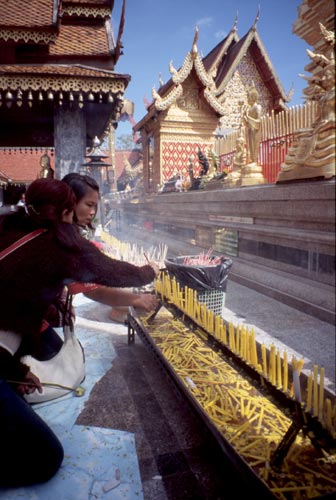
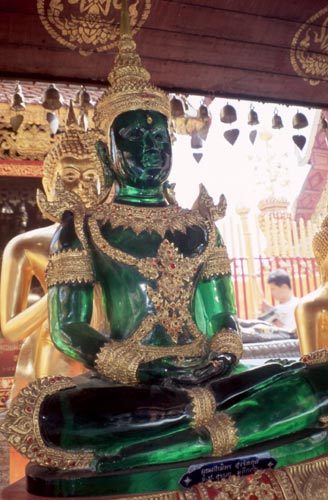
Luang Nam Tha, Laos
28 Jan. 2005
Bill and "Bessie Too" ride the
backroads of Laos
Dear Friends and Family,
I have reached this small town of northern Laos after a bumpy and very scenic cycle ride through tribal areas in the far northwestern corner of the country. Currently a layer of cool morning fog rests in the wide valley, but warm sunshine should break through within the hour.
Before leaving Chiang Mai in Thailand, I had to get ready for onward travels to China with a trip to the local Chinese consulate for a visa. With the application in, I hopped on an overnight train to Bangkok; the first two hours of the trip had fine scenery as the train chugged up a forested mountain range, passed by a national park, entered Thailand's longest railway tunnel, then wound down the other side of the mountain. When darkness fell, I climbed into my sleeping berth, which was comfortable enough, but I got little sleep due to the rough ride. At Bangkok's Hualumpong station, I took the new subway line over to my hospital for a follow-up to my skin surgeries; the doctor seemed pleased with the healing. Next I visited IQ Lab, one of Thailand's best photo labs, to process the five rolls of slides taken so far. I had bought a new Pentax Espio 24EW compact camera with an amazing 24-105 mm zoom lens for the trip. Film cameras may seem old fashioned, but no compact digital camera has such a wide-angle lens. I spent the afternoon with my Thai friend Chainat, who recently retired from government service with the public health ministry. He is very busy promoting community health and other programs. In the evening I picked up the processed slides and was pleased to see that they came out well. That night I returned to Chiang Mai on a VIP bus, a large bus with wide seats—only three seats across the width—and lots of legroom. A stewardess served a snack and drinks, plus I got a free midnight meal at a roadside restaurant. The bus was smoother than the train ride and only took 10 hours instead of the train's 14 hours; each mode of transport cost about $16 one way for the 800-km (500 mile) trip.
Back in Chiang Mai, I headed west by truck up into the hills to Doi Suthep, site of one of Thailand's most sacred stupas. It gleamed with gold and attracted many worshippers. Chiang Mai spread out far below. At the base of the mountain I stopped to wander through the vast Chiang Mai Zoo. The beautiful birds and big game animals were impressive, but I most enjoyed feeding baby elephants some sugar cane and bananas. I was surprised to see penguins and cape seals splashing about here in the mountains of northern Thailand, so far from their native homes.
|
Wat Phra That atop the mountain of Doi Suthep, west of
Chiang Mai. |
|
 |
 |
Just before heading out of Chiang Mai, I had the last task of picking up my Chinese visa. I was disappointed to find it only good for 30 days and at a higher cost because it was a double entry version. I pointed out that I had requested a 60-day, single entry visa. The officials dug out my application to verify, then whipped up my desired visa in just 10 minutes.
Two days and two tough mountain ranges to climb took me to the lakeside town of Phayao ("pah-yow"), which had a fine regional museum and several large temples. One temple had a "heaven and hell sculpture garden"; the heaven sculptures looked boring as you would expect, but the hell scenes had wildly grisly scenes of souls boiling in a pot, torn to pieces, or reborn in hideous shapes.
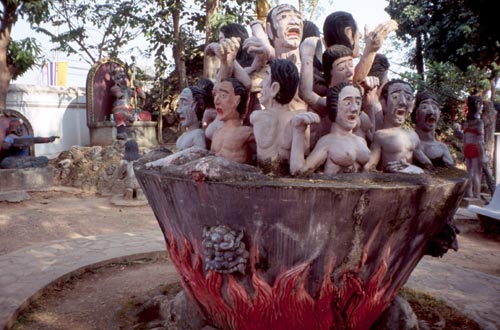
Sculpture garden at Wat Si Khom Kham, in Phayao (northeast of Chiang Mai)
Two days of riding through farmlands and gentle hills brought me to the mighty Mekong River. On the last day in Thailand I got my first rain shower, though it occurred in the night and the roads were dry by morning. I also met the first cyclists I had seen while riding in Thailand. They were a couple from Holland and enjoying a one-month spin around the north.
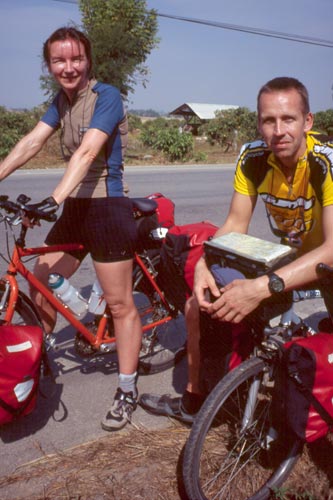
The Dutch cyclists
A five-minute ride in a large motorized canoe took me across the Mekong to the Lao town of Huay Sai. Immigration formalities were easy—just a few minutes of rubber stamping on each side. (I had picked up a Lao visa in Bangkok two months earlier.) From Huay Sai I could have retraced my route of two years ago to Luang Nam Tha, a three-day ride on unpaved roads. This time I wished to take a different route farther north. The trick was getting information on how to get started. Local travel agents knew only about boat charters, which cost more than $100. A bank teller told me of the 70-km road along the Mekong to the boat terminal at Ban Mom. The bank generously gave me more than ONE MILLION kip, the Lao currency, in exchange for a single $100 travelers check. Feeling filthy rich, I headed out of town on a scenic paved road with views of the swirling waters of the Mekong below. After 27 km the fun ended and I had to bump my way along a dusty and rough road the rest of the way to Ban Mom.
The next morning I checked out the boat situation, as the Mekong was the only highway to the north where I was headed. Not much was happening, so I charted a speedboat. They are like little rowboats but have a powerful truck engine swivel mounted on the rear. The boats are noisy (no mufflers) and go flat out at a fast 60 kph/40 mph. Life insurance wasn't included. The bicycle and I pretty much filled the little craft. We went roaring upstream, swerving around giant black rocks, little whirlpools, Chinese cargo boats, local fishing canoes, and a few small rapids. Burma lay on the left and Laos on the right. Fog shrouded the jungle mountains in spots. A few people lived along the river, mostly in isolated farms or in small villages. Two hours of excitement got me safely, if a little shaken, to the small town of Xieng Kok.
After lunch, I took a side road farther up along the Mekong for the views, then returned to the main road for the short ride east to Muang Luong. The roads were all unpaved and a bit dusty, but ok to ride. Many different tribes had villages along the way. Kids were very friendly, waving and yelling out "sabay di" (hello). Women often wore elaborate silver headdresses, sometimes including silver coins. Other women wore turbans and some seemed to have shaved heads. I couldn't help but notice that many women—both young and old—didn't worry about covering their breasts. I guess it's cooler that way.
Muang Luong was just a big village, but had a pleasantly rustic guesthouse and a few simple restaurants. I spent the next day wandering around the market, houses, river, and rice fields. A suspension bridge across the river had so many rotten boards that I dared not cross, though locals merrily trotted over it. I waded across the river, then followed a little road high into the mountains. Reactions from locals were mixed when they saw my apparition. Women and children sometimes screamed and fled, then watched from a safe distance. Other times they were friendly and waved hello. I enjoyed the views of rolling green hills and the flowers, birds, and lush vegetation of the jungle lining the road.
The Lao people love noodle soup and seem happy to dine on noodles for every single meal. That was fine for me at first, but seeking something else, I tried a sleepy Chinese restaurant near the market; the menu was in Chinese and Lao, but a few words of Thai got me a tasty omelet.
The next day I continued the ride east past more villages and rice fields to Muang Sing, which seemed like a big city with paved roads, loads of guesthouses, restaurants with English menus, and a small cultural museum. I could have continued east just 20 km or so to the Chinese border, but this crossing is only open for Chinese and Lao people. Instead, I rode south on a wonderfully scenic paved road up a narrow valley that led to a mountain pass, where I wound down, down into the wide valley of the Nam Tha River.
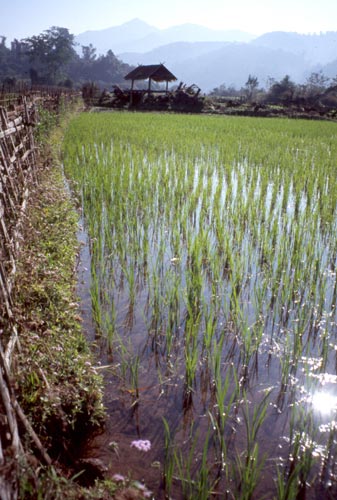 Newly planted rice near Muang Luong |
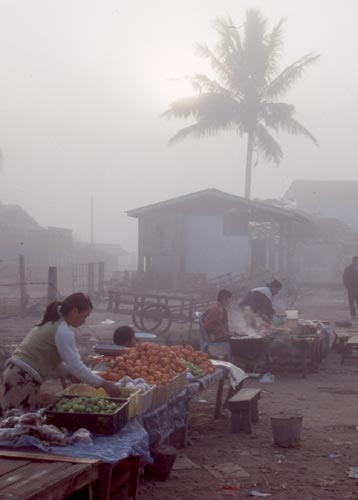 Market in Muang Sing |
|
|
|
Though just another small town, Luang Nam Tha amazed me in having an Indian restaurant that had opened since my visit here of two years ago. Quite a few travelers pass this way, stopping to trek or rest up on their journeys. I plan to do both. The border crossing that I will use for China lies just a half-day away to the northeast.
Happy Trails,
Bill Weir and "Bessie Too the Bicycle"